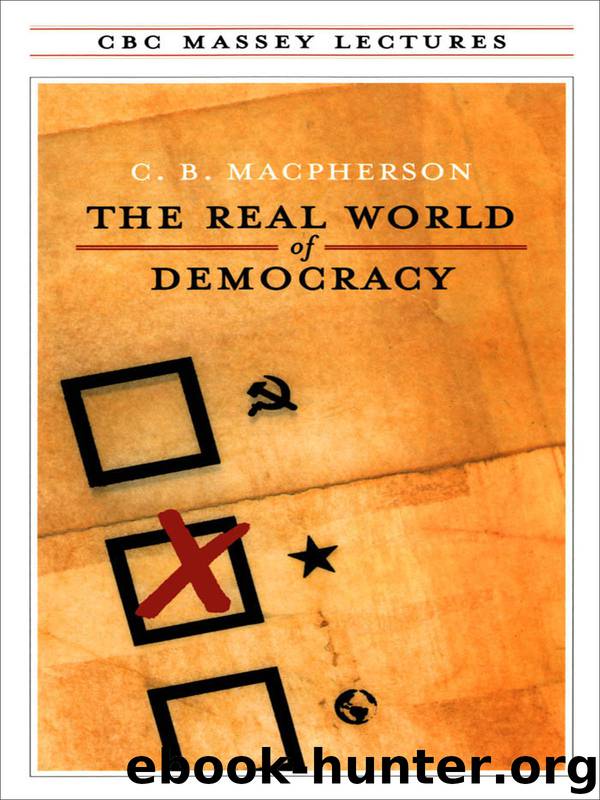The Real World of Democracy by C. B. Macpherson

Author:C. B. Macpherson
Language: eng
Format: epub
Tags: FIC000000
Publisher: House of Anansi Press Inc.
Published: 1992-04-29T04:00:00+00:00
IV
LIBERAL-DEMOCRACY AS A SYSTEM OF POWER
OUR INVESTIGATION SO FAR has shown us that there are three concepts of democracy actively at work in the world today, each one shaping and being shaped by a particular kind of society at a particular stage of development. There is our Western liberal-democracy, which we saw was brought into being to serve the needs of the competitive market society. Liberal-democracy is a fairly late product of the market society; the first need of the market society was for the liberal state, not a democratic one: a liberal state which was designed to operate by competition between political parties responsible to a non-democratic electorate. The democratic franchise was added only when the working-class that had been produced by the capitalist market society had become strong enough to get into the competition, strong enough to demand that it should have some weight in the competitive process. Liberal-democracy is thus the unique product of successfully developing capitalist market societies.
We have seen also the two non-liberal kinds of democracy, both of them closer than ours to the original notion of democracy as rule by and for the poor and oppressed, a notion that had nothing liberal about it. The modern communist concept, we saw, took the old notion and made it more precise and schematic by reading into it a specific class content and a specific time scheme. Democracy, for Marx and Lenin, meant in the first instance, rule by or for the proletariat. It was a class state, to be created by proletarian revolution, and to have the job of holding down the old ruling class while transforming the whole society in such a way that there would be no more basis for exploitive classes and so no more need for a class state. Only then could class democracy give way to a fully human society.
We saw, finally, a third concept of democracy, neither liberal nor communist, which prevails in the third world of the newly independent underdeveloped countries. It rejects the competitive ethos of the market society and sees no need for the competitive system of political parties. But while it thus adopts the pattern of the one-party state, it rejects the communist idea that where a people has broken away from capitalism the post-revolutionary state must be a class state. It sees instead the possibility of operating immediately as a classless society and state. Democracy, in this view, becomes immediately rule by the general will: this starts the moment national independence is attained.
The real world of democracy consists of all these three kinds, not just of any one of them. It is just as unrealistic for us to assume that ours is the only true democracy as it is for the Soviets or the third world to insist that theirs is the only genuine kind. The three kinds are indeed so different that one might ask whether one word should properly be used to describe them all. Can three such different animals really be given the same name? The simplest answer is that they are in fact given the same name.
Download
This site does not store any files on its server. We only index and link to content provided by other sites. Please contact the content providers to delete copyright contents if any and email us, we'll remove relevant links or contents immediately.
| Anthropology | Archaeology |
| Philosophy | Politics & Government |
| Social Sciences | Sociology |
| Women's Studies |
The Secret History by Donna Tartt(16656)
The Social Justice Warrior Handbook by Lisa De Pasquale(11492)
Thirteen Reasons Why by Jay Asher(7800)
This Is How You Lose Her by Junot Diaz(5794)
Weapons of Math Destruction by Cathy O'Neil(5046)
Zero to One by Peter Thiel(4834)
The Myth of the Strong Leader by Archie Brown(4795)
Promise Me, Dad by Joe Biden(4454)
Beartown by Fredrik Backman(4429)
Stone's Rules by Roger Stone(4422)
How Democracies Die by Steven Levitsky & Daniel Ziblatt(4408)
The Fire Next Time by James Baldwin(4349)
100 Deadly Skills by Clint Emerson(4085)
A Higher Loyalty: Truth, Lies, and Leadership by James Comey(4038)
Rise and Kill First by Ronen Bergman(4018)
The David Icke Guide to the Global Conspiracy (and how to end it) by David Icke(3890)
The Farm by Tom Rob Smith(3878)
Secrecy World by Jake Bernstein(3788)
The Doomsday Machine by Daniel Ellsberg(3736)
